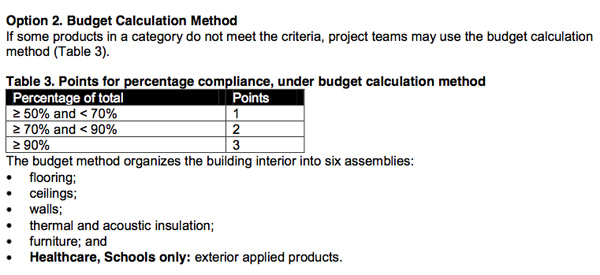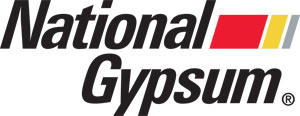Gypsum’s Role in Earning Points in LEED v4 EQ, and Other Credits
The second option is the “Budget Calculation Method,” which awards 1 to 3 points for various percentages of compliance:xi

Source: LEED Reference Guide for Building Design and Constructionxviii
Budget Calculation Method
The budget method organizes the building interior into six assemblies:
• Flooring
• Ceilings
• Walls (including gypsum assemblies)
• Thermal and acoustic insulation
• Furniture
• Exterior applied products (Healthcare, Schools only)
The requirements of this credit in LEED v4 are expected to produce cleaner indoor air by eliminating toxins at the source. Study after study shows that indoor air can be many times more polluted that outdoor air, partly due to off gassing from building materials. And the consensus is consistent: To solve the problem, eliminate the source.
Products that will contribute toward satisfying LEED credits must be tested and certified. The most common third-party testing and certification system for indoor air quality is GREENGUARD, administered by UL Environment, a business unit of UL. The focus of GREENGUARD is on specifying and installing low-emitting materials, which is considered more beneficial factor than TVOC analysis.
To earn a GREENGUARD certification for low-emitting products, the primary test method is called: “Standard Method for Measuring and Evaluating Chemical Emissions from Building Materials, Finishes and Furnishings Using Dynamic Environmental Chambers.”
This test method, according to GREENGUARD, follows the guidance of a number of standards, including:
• ASTM Standards D-5116 and D-6670
• U.S. Environmental Protection Agency's (USEPA) testing protocol for furniture
• State of Washington's protocol for interior furnishings and construction materials
• Germany’s Blue Angel Program
• California’s Department of Public Health Services (CDPH) Standard Practice for Specification Section 01350
• USO 16000 environmental testing series
The LEED reference guide suggests “products that meet the compliance thresholds established by recognized standards, or choose product classified as inherently non-emitting.”xii Gypsum board is indeed an inherently non-emitting product that meets compliance thresholds.
Indoor Environmental Quality Credit: Construction Indoor Air Quality Management Plan
This credit makes 1 point possible for these LEED v4 rating systems: BD+C: New Construction, BD+C: Core and Shell, BD+C: Schools, BD+C: Retail, BD+C: Data Centers, BD+C: Warehouses and Distribution Centers, BD+C: Hospitality, and BD+C: Healthcare.
The intent of the credit is: “To promote the well-being of construction workers and building occupants by minimizing indoor air quality problems associated with construction and renovations.”xiii
The LEED guide acknowledges “construction activities adversely affect indoor air quality when they generate dust, toxic substances, or other contaminants.”xiv
With a nod to worker well-being, teams are required to develop and implement an indoor air quality management plan that covers both the construction and preoccupancy phases of the building.
For the LEED BD+C: Healthcare rating system, which covers interiors with particularly critical needs for a protective plan, teams must develop and implement a moisture control plan to protect stored on-site and installed absorptive materials from moisture damage, and remove and replace materials susceptible to microbial growth. Fiberglass mat gypsum panels are well established as being low contributors to microbial growth. And because absorbent materials exposed to moisture during construction can degenerate and mold some time after installation, it’s important to both specify materials of low mold risk and to protect them during construction.
In addition, the credit requires maintenance of a clean jobsite, which will result in fewer contaminants to manage and control.
Finally, the use of tobacco products during construction will be, under LEED v4, explicitly prohibited inside the building during construction, and within 25 of the building entrance (or greater if required by local laws).xv
How Gypsum Contributes Toward Achieving Additional LEED Points
The use of natural or byproduct gypsum can help teams earn points in a number of other credit categories in LEED v4.
Materials and Resources Credit: Building Product Disclosure and Optimization – Sourcing of Raw Materials SUBHEAD
The intention of this credit is: “To encourage the use of products and materials for which life-cycle information is available and that have environmentally, economically, and socially preferable life-cycle impacts. To reward project teams for selecting products verified to have been extracted or sourced in a responsible manner.”xvi
To satisfy this credit, teams must “Use at least 20 different permanently installed products from at least five different manufacturers that have publicly released a report from their raw material suppliers which include raw material supplier extraction locations, a commitment to long-term ecologically responsible land use, a commitment to reducing environmental harms from extraction and/or manufacturing processes, and a commitment to meeting applicable standards or programs voluntarily that address responsible sourcing criteria.”xvii
Or, as a second option, they must use products that meet at least one of several stated responsible extraction criteria for at least 25 percent, by cost, of the total value of permanently installed building products in the project.
The criterion for recycled content is: “The sum of postconsumer recycled content plus one-half the pre-consumer recycled content, based on cost. Products meeting recycled content criteria are valued at 100 percent of their cost for the purposes of credit achievement calculation.”xviii
As a bonus, products that are extracted, manufactured and purchased within 100 miles of the project site are valued at 200 percent of their base contributing cost.
It’s possible fewer architects will strive for regional material points, however, because in LEED v4, the requirement has been reduced from 500 miles from the site (as was the case in LEED 2009) to 100 miles.
Materials and Resources Credit: Building Product Disclosure and Optimization – Material Ingredients SUBHEAD
This credit in LEED v4 provides the opportunity for 1 to 2 points for BD+C: New Construction, BD+C: Core and Shell, BD+C: School, BD+C: Retail, BD+C: Data Centers, BD+C: Warehouse and Distribution Centers, BD+C: Hospitality, and BD+C: Healthcare.
This intent of this credit is to encourage the use of products and materials that have environmentally, economically and socially preferable life-cycle impacts, and for which life-cycle information is available.
There are three options for meeting the requirements: 1) material ingredient reporting, 2) material ingredient optimization, or 3) product manufacturer supply chain optimization.
Option 1, which the gypsum industry is following, calls for use of at least 20 permanently installed products from at least five different manufacturers that use any of these programs to demonstrate the chemical inventory of the product to at least 1000 ppm, or 0.1%:
• Manufacturer inventory
• Health product declaration (HPD)
• Cradle to Cradle Certified, or
• USGBC approved program
The gypsum industry has in large part developed the life-cycle analyses and environmental product declaration required, and is now working on HPDs.
Conclusion
With the shift to product transparency and pollutant source control so evident in LEED v4, the use of natural and byproduct gypsum board is a natural fit for helping to achieve LEED certification. This product as developed and manufactured by major national gypsum companies that are committed to sustainability is a proven and reliable addition to the high-quality LEED-certified buildings. In particular, the use of gypsum board helps earn credits in the Indoor Environmental Quality category, serving as a proven low-VOC emitting material that conforms fully to widespread consensus on how to achieve healthy indoor air: Eliminate the source of the chemicals. With that intention and that process, the humans who occupy buildings certified under the stringent LEED v4 criteria have a better chance of enjoying better health, comfort and productivity.
Endnotes
i http://www.usgbc.org/about/history
iii http://www.aia.org/aiaucmp/groups/aia/documents/pdf/aiab104164.pdf
iv http://productguide.ulenvironment.com/ProductDetail.aspx?productID=7193&BrandID=584
v http://www.usgbc.org/resources/leed-reference-guide-building-design-and-construction
vi http://www.ncbi.nlm.nih.gov/pmc/articles/PMC2072857/
vii http://www.usgbc.org/resources/leed-reference-guide-building-design-and-construction
viii http://www.usgbc.org/resources/leed-reference-guide-building-design-and-construction
ix http://www.usgbc.org/resources/leed-reference-guide-building-design-and-construction
x http://www.usgbc.org/resources/leed-reference-guide-building-design-and-construction
xi http://www.usgbc.org/resources/leed-reference-guide-building-design-and-construction
xii http://www.usgbc.org/resources/leed-reference-guide-building-design-and-construction
xiii http://www.usgbc.org/resources/leed-reference-guide-building-design-and-construction
xiv http://www.usgbc.org/resources/leed-reference-guide-building-design-and-construction
xv http://www.usgbc.org/resources/leed-reference-guide-building-design-and-construction
xvi http://www.usgbc.org/resources/leed-reference-guide-building-design-and-construction
xvii http://www.usgbc.org/resources/leed-reference-guide-building-design-and-construction
xviii http://www.usgbc.org/resources/leed-reference-guide-building-design-and-construction
 |
National Gypsum, a fully integrated manufacturer of building products, offers three core Brands: Gold Bond® Gypsum Board, ProForm® Drywall Finishing and PermaBase® Cement Board. Our education courses educate architects on all aspects of construction using gypsum board and related products for wall and ceiling assemblies. http://www.nationalgypsum.com/ |








